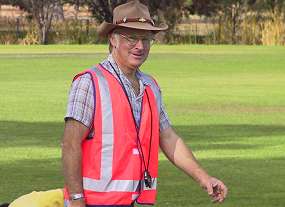
|
A description with control line emphasis of the Australian Model Aircraft National Championships held at Busselton, WA, in April 2001. This report from Charlie Stone, writing for his TARMAC club newsletter: |
|
|
|
The weather started off looking a bit suspect for the week of the Nationals proper, with strong winds and gloomy skies that threatened rain, but by the end of the week the breezes had abated and the showers stopped. The flying venues were well chosen.
Team Time 1. Langworth/Campbell 7.03.2 2. Fitzgerald/Ellins 7.41.5 3. Justic/Owen 8.37.56 Next was Goodyear, which was conducted in slightly less windy conditions than the F2C event. The fastest team was Fitzgerald/Walton, but they were handicapped by leaky tank valve problems and ended up in third place leaving first place to Fry/A Taylor and second to the veterans Stivey/Adler. Combined speed was held in wet and windy conditions and the first three placings were: Pl. Name Class Speed % Record 1. R. Fry Proto 29 190.79 87.01 2. R. Fry Jet 242.22 84.61 3. D. Axon Jet 194.00 67.77
Team Time 1. Fitzgerald/Walton 7:53.03 2. Fry/Taylor 7:56.9 3. Hunting/Taylor 8:06.26
Team Time
1. Langworth/Bertina 7:08.49
2. Kirton/Stone 7:45.43
3. Fry/Taylor 8:22.20
Vintage combat finished up the Control Line events at the Busselton Nationals. As always combat drew a good crowd who appreciated the flying and applauded good bouts. The vintage style of models are very sturdy and combined with the soft surface survived most impacts unharmed. The final places were: 1. Fred Adler using Taipan powered `Ironmongers'. 2. Garry Turna using PAW? Powered `Ironmongers' 3. Bob Fry using ST G20 .15D powered `Super Splinters' Among the items of interest on display was the engine test rig of Turbo Jet Technologies that was supplied and operated by Chris Mounkley to demonstrate his fantastic West Australian made gas turbine engines. I was shown some of the rotating bits of the engine as it was dismantled and I can attest to the fact that this is a beautifully made and very professional piece of equipment. A world leader. It is even more impressive when you see the ease with which it can be started and operated. These engines are kerosene burners and come in 6 kilogram and 18 kilogram thrust sizes. At present he is gearing up for large scale production here and will soon be the largest producer of model gas turbines in the world. Watch out for TJT engines; they will be coming to a competition near you.. |
Free FlightSeveral of the events were affected by strong breezes and Free Flight is usually the most susceptible to this pestilence. Entrants in open rubber had a very hard time and I considered tying myself to a tree so as not to be blown down wind as far as Trevor Letchford's best model. A triumph for another TARMAC member was when Adrian Dyson won open power with a consistent performance and three Maxes using a Jim Stivey designed `Stone Axe' Slow open power model. Fortunately, by the time that Chuck Glider and day Scramble came around the breeze had calmed to a gentle drift. The field was an excellent open venue, dusty and liberally scattered with traces of a recent occupation by cows. I watched the Chucky event with interest as a great variety of shapes and sizes of aircraft were flung up and variously fluttered down, floated away or speared into the cowpats or the gray dirt. I saw Bob Fry enjoying his first experiences with a really successful model. One absolute standout performer was a young bloke by the name of Paul Mitchell. I could have watched him for hours. He had some very well trimmed out models and a right arm like a missile launcher. His models when thrown would leave his hand with a distinctive moaning whistle that sounded like it was nearing sonic speeds and the amazing height gained always ended in a beautiful transition to gliding flight. He won the day and richly deserved to do so.
|
|
What control line is | Beginnings | Organisation | Competition categories | Racing | Aerobatics | Speed | Vintage |Combat | Contest News | Pranks & Jokes | Personalities | Engines | What went wrong | Magazines | Current Newsletters | 40 Years On | Readers pictures | Plans | Grant Potter's | Contributors | Links | Postcards | Site Search |Home Page |
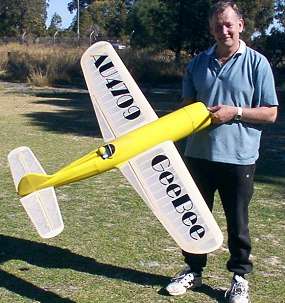 The first weekend in April saw intensive activity at the TARMAC flying field as the usual sport fliers rubbed shoulders with the competitive types getting ready for the Nationals. Hans Bertina was practicing with his new Gee Bee stunter which is designed on similar lines to full sized aerobatic aircraft. It has a huge, round section fuselage and comparatively small wings with much smaller flaps than usually seen on competition stunters. The power plant is a four stroke Saito .56 that really has some pulling power, as is obvious to anyone that has launched it. It is like trying to hold back a tractor. Typical of four stroke engines, it is very quiet and the engine note is not at all obtrusive.
The first weekend in April saw intensive activity at the TARMAC flying field as the usual sport fliers rubbed shoulders with the competitive types getting ready for the Nationals. Hans Bertina was practicing with his new Gee Bee stunter which is designed on similar lines to full sized aerobatic aircraft. It has a huge, round section fuselage and comparatively small wings with much smaller flaps than usually seen on competition stunters. The power plant is a four stroke Saito .56 that really has some pulling power, as is obvious to anyone that has launched it. It is like trying to hold back a tractor. Typical of four stroke engines, it is very quiet and the engine note is not at all obtrusive.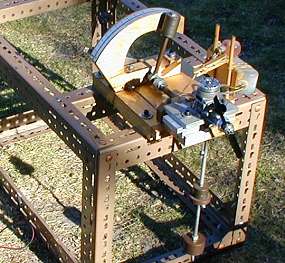
 The Control Line events kicked off with the premier racing event F2C. The wind at this time was strong enough to be a worry and rain clouds were blowing in from the coast, though no rain actually fell. Another concern was the proximity of the Pylon racers, who were a little too close for comfort and perhaps safety too. As expected, the visiting Brits Bernie Langworth and Dave Campbell performed very well. Well enough in fact to win quite easily as they had just done at the Victorian State championships a week before. Although they had quite a fast model, there was absolutely no time wasted in the handling of the model. Pit stops were lightning fast and the whole show was very professional. Placings were:
The Control Line events kicked off with the premier racing event F2C. The wind at this time was strong enough to be a worry and rain clouds were blowing in from the coast, though no rain actually fell. Another concern was the proximity of the Pylon racers, who were a little too close for comfort and perhaps safety too. As expected, the visiting Brits Bernie Langworth and Dave Campbell performed very well. Well enough in fact to win quite easily as they had just done at the Victorian State championships a week before. Although they had quite a fast model, there was absolutely no time wasted in the handling of the model. Pit stops were lightning fast and the whole show was very professional. Placings were: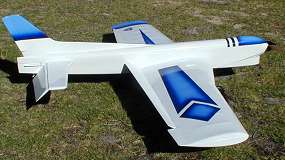 Onward ever onward, to the next event of Aerobatics (or Stunt to those of us that live in the past). This was a dull day which is always good for Stunt as you don't have problems of the usual sun blindness when the wind blows towards the sun, which for some reason it usually does. A slightly variable breeze caused a few problems. This is the first time that National Stunt has been run in WA since the 1980 Nats at Albany when it was won by Frank Battam. This year it was won by Paul Turner from NSW using his `Wind Wizard' model powered by ST .46. Paul had a setback in his first flight when his outboard flap pushrod disconnected itself from the flap horn and caused some very unusual flying characteristics. He did some hasty repairs and had it back in action as good as ever in short order. Oddly enough the other two place getters had both flown and placed in those 1980 nationals at Albany. Albeit in reverse order to this time. In second place was Stuart Sherlock flying a `Firecracker' powered by Enya .45. This was a pleasant change as he has had engine run problems in bulk for months and he obviously sorted them out at just the right time. Third was taken by Peter Smith of Canberra, who flew an own design, take-apart model powered by an ST .46.
Onward ever onward, to the next event of Aerobatics (or Stunt to those of us that live in the past). This was a dull day which is always good for Stunt as you don't have problems of the usual sun blindness when the wind blows towards the sun, which for some reason it usually does. A slightly variable breeze caused a few problems. This is the first time that National Stunt has been run in WA since the 1980 Nats at Albany when it was won by Frank Battam. This year it was won by Paul Turner from NSW using his `Wind Wizard' model powered by ST .46. Paul had a setback in his first flight when his outboard flap pushrod disconnected itself from the flap horn and caused some very unusual flying characteristics. He did some hasty repairs and had it back in action as good as ever in short order. Oddly enough the other two place getters had both flown and placed in those 1980 nationals at Albany. Albeit in reverse order to this time. In second place was Stuart Sherlock flying a `Firecracker' powered by Enya .45. This was a pleasant change as he has had engine run problems in bulk for months and he obviously sorted them out at just the right time. Third was taken by Peter Smith of Canberra, who flew an own design, take-apart model powered by an ST .46. Then came Bendix racing, a favourite of the West Aussies, though rumours abound that it originated in Queensland. A likely story you say. There was even a Queenslander here in the form of John Taylor, and he had a very potent Bendix racer powered by a heavily modified Super Tigre heli engine and John Hunting along with him to fly it. The weather was dull again with little or no breeze. Just how I like it. There were several ruptured engines in the heats of this event which took out Bellis/Mills and Hoogenkampf/Leknys. It almost got Steve Walton who, having cracked a crankshaft, methodically worked his way through all of Bob Fry's spare engines in a successful attempt to remain competitive. He even tried seeking sympathy by referring to his entry as a `Lame duck team'. Ha! A wolf in lame duck's clothing. Hunting/Taylor were very fast, but came unstuck with a shutoff problem that kept them on the ground for an extra 20 seconds in one of the pit stops in the final. Fry/Taylor put in the fastest heat time of 3:40.9. The final placings were:
Then came Bendix racing, a favourite of the West Aussies, though rumours abound that it originated in Queensland. A likely story you say. There was even a Queenslander here in the form of John Taylor, and he had a very potent Bendix racer powered by a heavily modified Super Tigre heli engine and John Hunting along with him to fly it. The weather was dull again with little or no breeze. Just how I like it. There were several ruptured engines in the heats of this event which took out Bellis/Mills and Hoogenkampf/Leknys. It almost got Steve Walton who, having cracked a crankshaft, methodically worked his way through all of Bob Fry's spare engines in a successful attempt to remain competitive. He even tried seeking sympathy by referring to his entry as a `Lame duck team'. Ha! A wolf in lame duck's clothing. Hunting/Taylor were very fast, but came unstuck with a shutoff problem that kept them on the ground for an extra 20 seconds in one of the pit stops in the final. Fry/Taylor put in the fastest heat time of 3:40.9. The final placings were: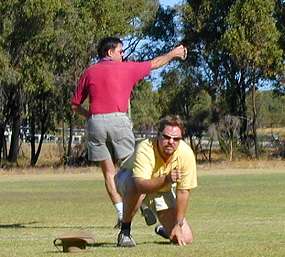 Vintage A team racing was next and this was an event that I was in rather than looking at, so the perspective is a bit different. The weather had changed a bit since the morning Bendix racing, and for a while the sun came out and even got quite hot for a while. At one stage the sun shone while drizzling rain fell aided by a light breeze and silly as it might sound, if you stood still, one side cooked in the sunlight, while the other side was evaporatively cooled and nearly got frozen. I think that it has put a permanent curve in my backbone. Most unpleasant and it also played havoc with the engine settings. Mine at any rate. Another feature was the flying surface which firm enough to walk on, but rather glutinous in patches and landing models tended to stick where they hit it, causing some very unplanned shifting of segments. The gluey patches had a surface only slightly firmer than blancmange, which was a blessing in disguise to the fast team of Langworth/Bertina when a down line broke just after completion of their first heat and after performing two giant loops, the ex-Duggan `Elliptic' plunged into the deck. The only damage was a bent undercarriage and broken off needle valve. Dennis Prior must build 'em strong as well as light. Just a few minutes work to fit a new set of lines and it was as good as new. With the heats out of the way, the final went well with clean racing. No one had any real problems and we had good starts and pit stops. Langworth/Bertina were clearly the fastest on the day. The final placings were:
Vintage A team racing was next and this was an event that I was in rather than looking at, so the perspective is a bit different. The weather had changed a bit since the morning Bendix racing, and for a while the sun came out and even got quite hot for a while. At one stage the sun shone while drizzling rain fell aided by a light breeze and silly as it might sound, if you stood still, one side cooked in the sunlight, while the other side was evaporatively cooled and nearly got frozen. I think that it has put a permanent curve in my backbone. Most unpleasant and it also played havoc with the engine settings. Mine at any rate. Another feature was the flying surface which firm enough to walk on, but rather glutinous in patches and landing models tended to stick where they hit it, causing some very unplanned shifting of segments. The gluey patches had a surface only slightly firmer than blancmange, which was a blessing in disguise to the fast team of Langworth/Bertina when a down line broke just after completion of their first heat and after performing two giant loops, the ex-Duggan `Elliptic' plunged into the deck. The only damage was a bent undercarriage and broken off needle valve. Dennis Prior must build 'em strong as well as light. Just a few minutes work to fit a new set of lines and it was as good as new. With the heats out of the way, the final went well with clean racing. No one had any real problems and we had good starts and pit stops. Langworth/Bertina were clearly the fastest on the day. The final placings were: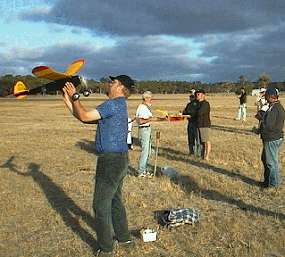 Day Scramble was held late in the afternoon and I was drafted as a timekeeper. This event was fun. It was an exciting hour, especially for the timekeepers who are right at the start line; although firing line would be a better description. Timekeepers not only have to time the flights of the model that they have been assigned to watch, they have to keep a beady eye on all the other aviation activity about them. With cries of `Heads' echoing about and various misguided missiles chugging aimlessly about the skies at low altitude, you need eyes in the back of your head if you want to avoid having a prop nut embedded there. I saw a tiny all balsa biplane spiraling steadily up towards invisibility, while the operator of the plane that I was timing slowly bloodied his fingers at ground level by struggling to start a tiny red headed Allen Mercury engine that wasn't yet ready to run. Many of the competitors, possibly as an indication of their state of fitness, had resorted to runners who were tasked with the job of model recovery, while others did it for themselves. Either way there were a lot of heavy panting going on and a liberal scattering of sweat and diesel fuel droplets into the dirt. At the end of the hour of competition, the flight line was quite peaceful as a lot of models were in the air on their last flights. They drifted gently downwind, silhouetted artistically against the high evening clouds, while out of our earshot, the faithful runners gasped along on their final pursuit. Scramble was won by a very well prepared Jim Stivey aided by his hyper fit runner Trevor Letchford and thus Jim ended up with responsibility for polishing the worlds largest perpetual trophy. Tarn Stowe took second using his own legs and operating a highly dangerous (low) flying carpet. In third was Norm Kirton, who did most of his own running, which is not bad for one of his advanced years.
Day Scramble was held late in the afternoon and I was drafted as a timekeeper. This event was fun. It was an exciting hour, especially for the timekeepers who are right at the start line; although firing line would be a better description. Timekeepers not only have to time the flights of the model that they have been assigned to watch, they have to keep a beady eye on all the other aviation activity about them. With cries of `Heads' echoing about and various misguided missiles chugging aimlessly about the skies at low altitude, you need eyes in the back of your head if you want to avoid having a prop nut embedded there. I saw a tiny all balsa biplane spiraling steadily up towards invisibility, while the operator of the plane that I was timing slowly bloodied his fingers at ground level by struggling to start a tiny red headed Allen Mercury engine that wasn't yet ready to run. Many of the competitors, possibly as an indication of their state of fitness, had resorted to runners who were tasked with the job of model recovery, while others did it for themselves. Either way there were a lot of heavy panting going on and a liberal scattering of sweat and diesel fuel droplets into the dirt. At the end of the hour of competition, the flight line was quite peaceful as a lot of models were in the air on their last flights. They drifted gently downwind, silhouetted artistically against the high evening clouds, while out of our earshot, the faithful runners gasped along on their final pursuit. Scramble was won by a very well prepared Jim Stivey aided by his hyper fit runner Trevor Letchford and thus Jim ended up with responsibility for polishing the worlds largest perpetual trophy. Tarn Stowe took second using his own legs and operating a highly dangerous (low) flying carpet. In third was Norm Kirton, who did most of his own running, which is not bad for one of his advanced years.